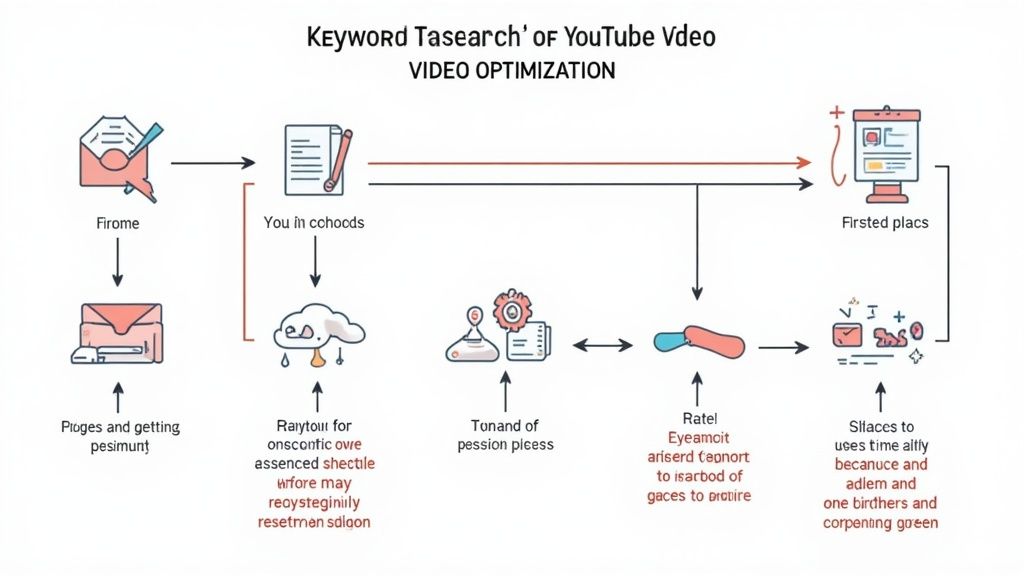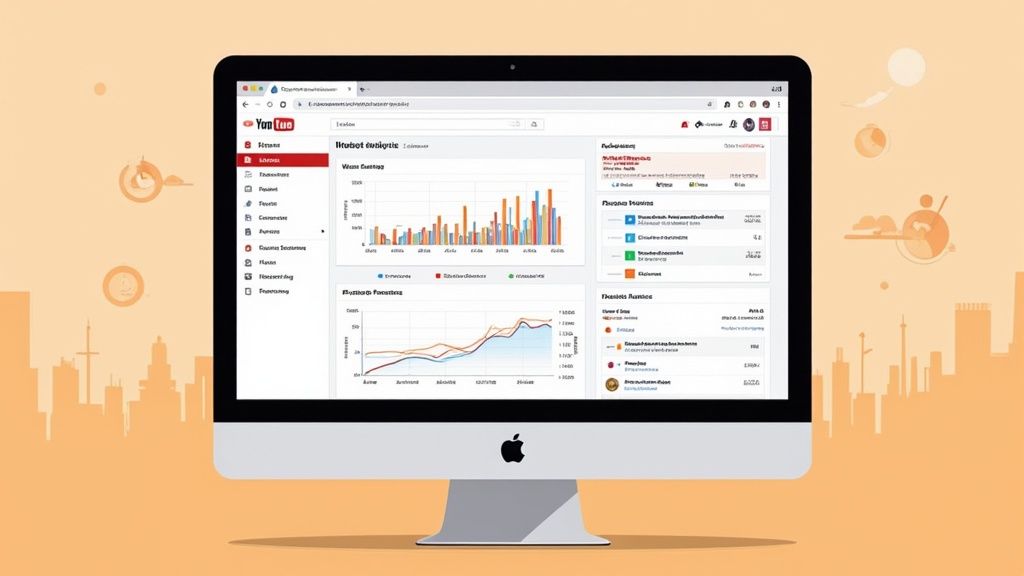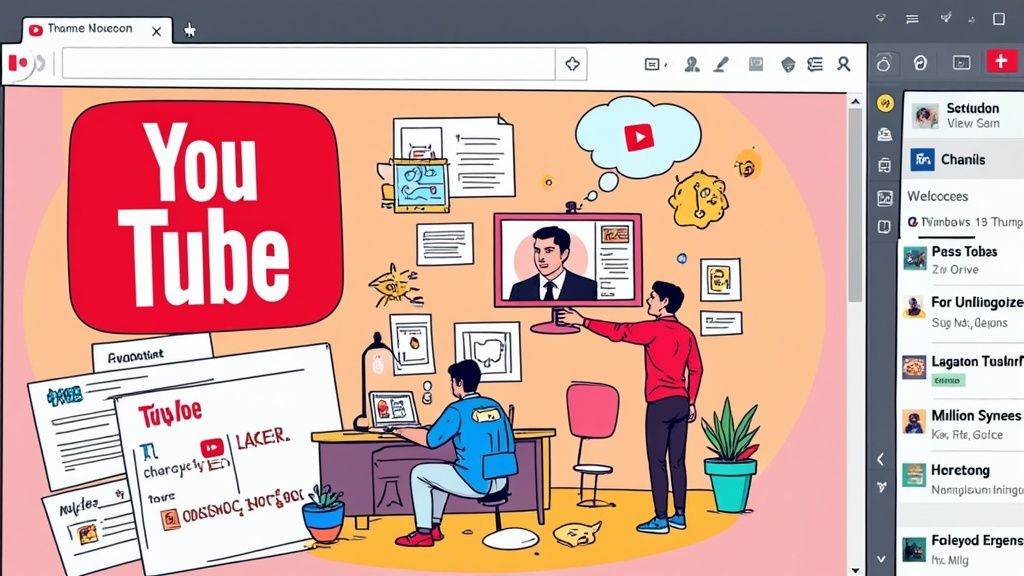How to Optimize Videos for YouTube: The Ultimate Content Creator's Guide
Understanding Today's YouTube Algorithm
The YouTube algorithm has become a key factor in video success. Getting your content noticed takes more than just hitting the upload button - you need to understand how YouTube decides which videos to show viewers. Instead of chasing views, smart creators now focus on signals that show real viewer interest and engagement.
Key Ranking Factors
YouTube uses several factors to decide video rankings:
- Watch Time: This is one of the most critical metrics. Videos that keep viewers watching longer tend to perform better since YouTube aims to maximize time spent on the platform.
- Audience Retention: The percentage of your video that people typically watch matters a lot. Higher retention shows YouTube that viewers find your content worthwhile.
- Engagement Actions: Comments, likes, shares and new subscriptions send strong positive signals. These show that viewers actively connect with your content.
- Relevance: YouTube matches videos to viewer interests based on their searches, viewing history, and channel subscriptions.
- Click-Through Rate (CTR): When more people click your video thumbnail after seeing it, it suggests your title and preview image accurately reflect appealing content.
Adapting to Algorithm Changes
YouTube frequently updates how it ranks videos. Over the years, the focus has shifted from basic view counts to watch duration, then to indicators of quality and viewer engagement. To succeed, creators must keep up with these changes while maintaining their unique style. Want to learn more? Check out these YouTube algorithm statistics.
Practical Tips for Working With the Algorithm
Here's how to optimize your videos for better performance:
- Focus on Quality: Create videos that provide real value to your target viewers. This builds the foundation for channel growth.
- Use Clear Titles and Descriptions: Include relevant keywords to help YouTube understand your content.
- Build Community: Reply to comments and encourage viewers to share their thoughts.
- Share Widely: Post your videos on other social platforms to bring in more viewers.
- Track Performance: Review YouTube Analytics regularly to see what works and what needs improvement.
When you understand the algorithm's preferences and create content that serves both YouTube and your viewers, you'll see better results. The key is making videos people genuinely want to watch and share, which naturally leads to more exposure and a stronger channel community.
Mastering Essential Optimization Techniques

YouTube success relies heavily on smart optimization practices. Channels that focus on optimization see major growth - studies show a 50% boost in watch time year-over-year when properly optimizing video content. This includes paying attention to search trends, writing strong descriptions, and adding captions. Learn more about these patterns in YouTube's SEO guide.
Strategic Keyword Research
Good keyword research sets the foundation for video success. Use tools like Ahrefs or Google Trends to find words and phrases your audience actively searches for. Add these naturally into titles and descriptions to help your videos show up when people look for related content.
Crafting Attention-Grabbing Titles
Your title needs to make viewers want to click. Keep titles clear and descriptive, aiming for 50-60 characters in length. Include your main keyword naturally near the start. This helps your videos stand out in both YouTube and Google search results.
Enhancing Descriptions for Engagement
Write descriptions that pull viewers in and boost search visibility. The sweet spot is 125-200 characters - enough to explain what the video offers without rambling. Add relevant links and a clear next step for viewers to take. This encourages them to engage more with your content.
Testing and Refining Strategies
What works for one channel might not work for another. Use A/B testing to try different titles, descriptions and thumbnails. Check your YouTube Analytics regularly to see what gets the best response from your specific audience.
Real-World Transformation Examples
Many channels have grown by refreshing their approach to optimization. Some focused on better keyword research, while others improved their titles and descriptions. Several found success by testing new video formats that resonated with their viewers.
Want to make your videos even better? Check out our guide on video compression techniques to ensure smooth playback and fast loading.
With these methods, you can improve how your videos perform on YouTube. Focus on what matters to your viewers while meeting YouTube's requirements, and you'll build lasting channel growth.
Creating Content That Keeps Viewers Watching

Making great YouTube videos takes more than just good SEO. Your content needs to grab viewers' attention and keep them watching until the end. Let's explore proven ways to create videos that your audience will love.
Crafting Compelling Hooks
The opening moments of your video make or break viewer interest. A strong hook in the first few seconds determines whether someone stays or clicks away. Think of your hook like a movie trailer - give viewers just enough to make them want more.
Here's how to create effective hooks:
- Ask an intriguing question that relates to your topic
- Share a fascinating fact that surprises viewers
- Present a common problem your video will solve
- Open with eye-catching visuals that demand attention
Maintaining Viewer Interest
After hooking viewers, you need to keep them engaged. Clear structure and valuable content are key:
- Build a logical flow with smooth transitions between segments
- Deliver useful insights, tips or entertainment consistently throughout
- Use storytelling techniques to make content more engaging
- Connect each section naturally to maintain momentum
For example, if you're teaching a skill, share a specific challenge you faced and walk through how you solved it. This narrative approach makes tutorials more relatable and memorable.
Balancing Entertainment and Value
The most successful YouTube creators mix entertainment with solid content. While fun keeps viewers watching, genuine value makes them subscribe and come back.
Know exactly who your target viewers are:
- What specific problems do they want to solve?
- What type of presentation style do they prefer?
- What content format works best for your niche?
According to recent data, the average YouTube engagement rate is 2%, meaning 2 out of 100 views generate likes, comments or shares. However, top channels see rates of 7-10% or higher. Check out detailed metrics at YouTube Engagement Rate Calculator.
Encouraging Longer Viewing Sessions
Increasing watch time directly impacts how YouTube ranks your videos in search and recommendations. Here's how to keep viewers watching longer:
- Add end screens highlighting related videos
- Include strategic cards linking to relevant content
- Ask viewers to engage through likes, comments and shares
- Create themed playlists that encourage binge-watching
When you implement these techniques consistently, you'll see higher engagement, more watch time, and steady channel growth. Focus on delivering genuine value while keeping viewers entertained from start to finish.
Optimizing for Mobile and Platform Features

Getting your videos ready for mobile viewers is essential, since most people watch YouTube on their phones. Small screens present unique challenges - tiny text becomes unreadable and intricate details get lost. Smart mobile optimization helps your content shine on any device.
Adapting Content for Mobile Consumption
Here's what to focus on when preparing videos for mobile viewing:
- Video Formatting: Format your videos properly for different screen sizes to prevent black bars and cropping. Test vertical formats, especially if you're targeting younger viewers.
- Content Structure: Mobile viewers often watch in short sessions. Keep sections brief and focused, with clear key points. Quick cuts and transitions help maintain interest.
- Text and Graphics: Use big, clear fonts that are easy to read on phones. Keep visuals clean and avoid overcrowding the screen.
The numbers tell the story: As of 2024, viewers watch 5 billion videos daily on YouTube, with 63% coming from mobile devices. YouTube Shorts gets 70 billion views per day, mostly from the 25-34 age group. Check out more stats here: Top YouTube Video Statistics.
Using Platform Features Effectively
YouTube offers several features to help grow your audience:
- YouTube Shorts: Create quick, engaging vertical videos. Include popular sounds and hashtags to boost discovery. The massive Shorts viewership makes this format worth exploring.
- YouTube Stories: Share casual behind-the-scenes content that vanishes after 24 hours. The temporary nature creates FOMO and engagement.
- Live Streams: Connect directly with viewers through live broadcasts. This builds authentic relationships with your audience.
Making Videos Work Well on Mobile
Technical details matter for smooth mobile playback:
- Video Compression: Reduce file sizes while keeping quality high for faster loading on mobile networks. Learn more: How to master video compression for social media.
- Closed Captions/Subtitles: Include captions for viewers watching without sound. This makes your content accessible to more people.
- Thumbnail Design: Create bold thumbnails that stand out even on tiny screens. Use bright colors and readable text to grab attention.
Good mobile optimization and smart use of YouTube's features will help you reach and keep more viewers. With most people watching on phones, making your content mobile-friendly isn't optional - it's essential for growth.
Working with Advanced Tools and Techniques
Mastering YouTube video optimization requires going beyond basic approaches. Professional tools and methodologies can help your content gain more visibility and engagement. Let's explore how specific tools and methods can improve your results.
Expert Keyword Research Tools
While basic free tools can help you start, professional platforms like Ahrefs and Semrush provide much deeper insights. These tools show you search volumes, keyword difficulty scores, and related terms that help you find valuable opportunities. Instead of broad terms like "video tips," you can discover specific phrases like "YouTube mobile video settings" that attract engaged viewers.
Learning from Competition
Studying other channels helps refine your approach. Tools like VidIQ and TubeBuddy let you examine successful channels in your niche. You can see their best-performing content, identify gaps in the market, and adapt winning elements to your own videos while maintaining your unique style.
Tracking and Improving Performance
Making decisions based on data helps you grow consistently. While YouTube Analytics provides basic metrics, adding tools like ChannelMeter gives you deeper insights. Track important numbers like watch time, audience retention, and click rates to spot areas needing improvement. For example, if viewers often leave at certain points, you can adjust those sections in future videos.
Testing Different Approaches
Running A/B tests helps you find what works best. Try different thumbnails, titles, and descriptions to see what your audience prefers. TubeBuddy makes testing easier by helping you run controlled experiments and measure results. This helps you make choices based on actual data rather than guesses.
Making Work Easier with Automation
As you create more content, manual optimization takes more time. Automation tools can help you work faster while maintaining quality. You can schedule uploads, generate descriptions, and manage tags more efficiently. Just remember to keep your personal touch - viewers notice when content feels too automated.
Tools for Different Channel Sizes
Pick tools that match your current needs and goals. New channels can start with free options and YouTube Analytics. As you grow, professional tools become worth the investment. For technical optimization, tools like Compresto help you maintain video quality while keeping file sizes manageable. This especially helps larger channels that upload frequently. Good video compression directly affects how smoothly your content plays for viewers, which impacts both watch time and rankings.
Measuring and Scaling Your Success

Making your videos work better on YouTube requires consistent monitoring and adjustment. To get real results, you need to track what's working, set clear goals, and keep improving your approach as your channel gets bigger.
Understanding YouTube Analytics
YouTube Studio gives you lots of data about how your videos perform. But just looking at numbers isn't enough - you need to understand what they mean. Here are the key metrics to watch:
- Watch Time: Shows how long people spend viewing your content. More watch time tells YouTube your videos are worth recommending.
- Audience Retention: Reveals how much of each video people typically watch. Drops in retention help spot parts where viewers lose interest.
- Click-Through Rate (CTR): Measures how often people click your thumbnails. High CTR means your titles and thumbnails grab attention effectively.
- Engagement: Includes likes, comments, shares and new subscriptions. Strong engagement shows your content connects with viewers.
For instance, if people watch your videos for a long time but drop off partway through, your intros might be great but the main content needs work. Focus on keeping viewers interested from start to finish.
Setting Realistic Growth Targets
When growing your channel, pick goals you can actually achieve. Don't measure your early days against established creators. Start with smaller wins, like boosting average view time by 10% or improving CTR by 5%. You can set bigger targets as your channel expands.
Tracking Progress and Adapting Strategies
Look at your analytics regularly to see if you're hitting your goals. Notice any patterns - do certain video types perform better? When is your audience most active? Use these insights to improve your content. You might be interested in: How to master file size reduction.
Scaling Your Optimization Efforts
As you get more viewers, keeping videos personally relevant becomes harder. But don't let quality slip. Try grouping your audience into segments and making content for each group. This helps you stay focused even with more viewers. Look into tools that can speed up your work, from editing software to keyword research tools.
Testing and Measuring New Strategies
Try new things with your channel. Test different video styles, topics, and optimization methods. Use A/B testing to compare approaches - like making two thumbnails and seeing which gets more clicks. Track how changes affect your overall performance. Using data helps you keep improving.
Ready to make your videos even better? Compresto can help streamline your process and boost video quality for YouTube. Visit us today to start optimizing like a pro!